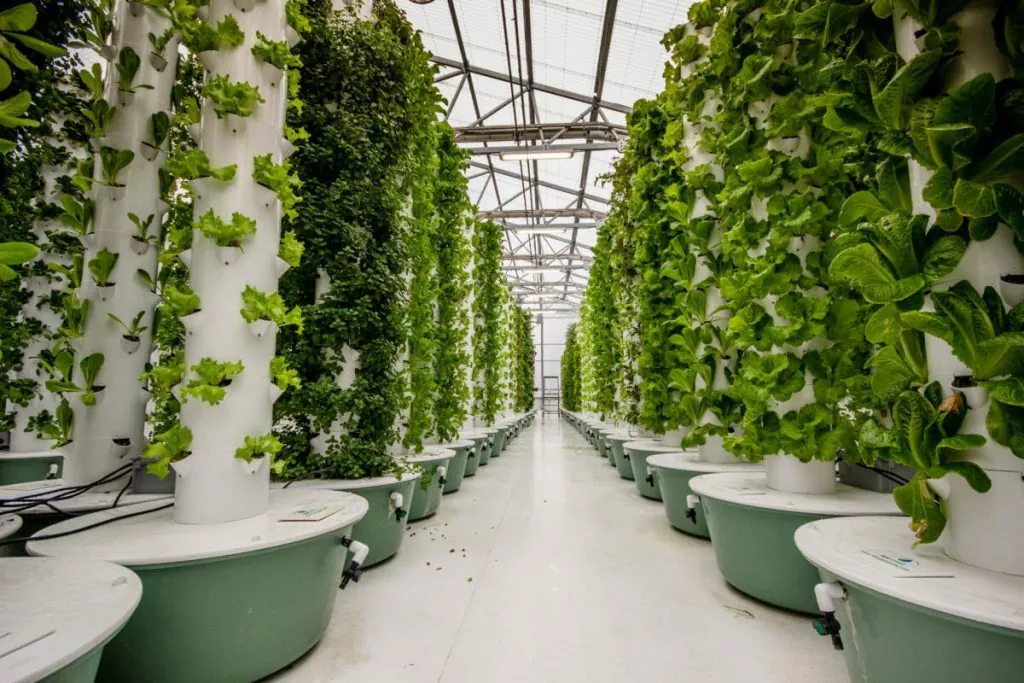Introduction:
Vertical aeroponic farming, also known as vertical farming or aeroponics, is an innovative approach to cultivating plants without soil, utilizing nutrient-rich water within a vertical framework. This cutting-edge technique is gaining traction among farmers and plant enthusiasts for its efficiency and sustainability. In this blog, we’ll explore the top 11 benefits of vertical aeroponic farming, examining why it stands out as an ideal solution for modern agriculture, especially for companies like Ponic Greens that aim to adopt sustainable, high-yield farming practices.
Space Efficiency:
A standout feature of vertical aeroponic farming is its efficient use of space. By growing plants vertically, farmers can maximize plant density, accommodating 300% more plants than the Nutrient Film Technique (NFT) and 200% more than the A-frame Deep Flow Technique (DFT). This makes it particularly suitable for urban environments and areas with limited arable land. Vertical aeroponic farms can thrive in various indoor settings, including warehouses and high-rise buildings, allowing for continuous production in spaces where traditional farming would be impractical.
Water Conservation:
With water scarcity being a major challenge in agriculture, vertical aeroponic farming offers a solution by using up to 95% less water than traditional soil-based methods. The system recycles nutrient-rich water, minimizing waste and promoting eco-friendly water use. This feature makes aeroponic farming an excellent choice for regions with limited water resources or water usage restrictions.
Reduced Pesticide Use:
Vertical aeroponic systems minimize the need for pesticides and herbicides by fostering a controlled growing environment, which reduces exposure to pests and diseases. This approach leads to healthier, pesticide-free produce, appealing to consumers looking for safe, high-quality food options.
Enhanced Crop Quality:
Through precise control over light, temperature, humidity, and nutrient levels, vertical aeroponic farming optimizes plant growth, resulting in higher yields, improved flavor, and greater nutritional content. The controlled environment also limits contamination from external factors, ensuring a cleaner, safer harvest.
Year-Round Production:
Vertical aeroponic farming enables year-round crop production, independent of weather or seasonal changes. This steady, controlled environment ensures a reliable supply of fresh produce throughout the year, addressing one of the key limitations of traditional farming tied to seasonal variations.
Increased Crop Yield:
This method allows for significantly higher crop yields compared to conventional farming techniques. By optimizing space and growing conditions, vertical aeroponics delivers increased yields per square foot, making it a lucrative option for commercial farming operations.
Energy Efficiency:
Vertical aeroponic systems can also be energy efficient. LED lighting provides optimal conditions for plant growth with lower energy usage than traditional lighting methods. Additionally, the recirculating system conserves resources, further lowering energy consumption and supporting environmental sustainability.
Reduced Carbon Footprint:
Traditional farming requires extensive transportation and storage, contributing to a large carbon footprint. Vertical aeroponic farms, often located near urban centers, reduce transportation needs and carbon emissions. Controlled environments with fewer chemicals contribute to a greener, more sustainable farming approach.
Scalability:
Vertical aeroponic systems are highly scalable, allowing farms to expand or adapt based on demand and available space. This modular design makes it easy to adjust operations as needed, supporting flexibility and growth.
Enhanced Plant Health:
With precise control over nutrients, pH levels, and environmental factors, vertical aeroponic farming promotes optimal plant health. Healthier plants are more resistant to pests and diseases, producing higher-quality and more resilient crops.
Sustainable Agriculture:
As a sustainable agricultural method, vertical aeroponic farming uses resources efficiently, minimizes environmental impact, and supports year-round production. It requires less water, pesticides, and energy while reducing soil erosion and contamination risks, making it a top choice for environmentally responsible agriculture.
Conclusion:
Vertical aeroponic farming presents a transformative opportunity for modern agriculture. Its space efficiency, water conservation, reduced pesticide use, enhanced crop quality, year-round production, increased yield, energy efficiency, lower carbon footprint, scalability, and sustainable practices make it an ideal option for forward-thinking companies like Ponic Greens. By adopting vertical aeroponic farming, farmers and companies alike can promote efficient and sustainable agriculture, ensuring a reliable and eco-friendly supply of fresh produce.

